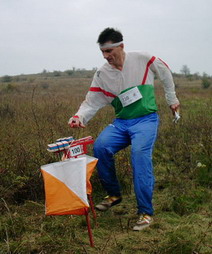
Back سباق موجه Arabic Səmti müəyyənetmə Azerbaijani Спорт ориентирлашыуы Bashkir Спартыўнае арыентаванне Byelorussian Спартовае арыентаваньне BE-X-OLD Спортно ориентиране Bulgarian Cursa d'orientació Catalan Orientační běh Czech Orientering (sportsgren) Danish Orientierungslauf German
 An orienteer punching a control point | |
| Highest governing body | International Orienteering Federation (IOF) |
|---|---|
| First public contest | 1897 Sweden–Norway[1] |
| Clubs | 78 national federations |
| Characteristics | |
| Contact | No |
| Team members | Individuals and teams of variable size |
| Mixed-sex | Yes, but usually in separate leagues/divisions |
| Type | Outdoor |
| Equipment | Compass, orienteering map, control punch |
| Presence | |
| Country or region | Worldwide |
| Olympic | No |
| World Championships | 1966[2] |
| World Games | 1995[3] |

Orienteering is a group of sports that involve using a map and compass to navigate from point to point in diverse and usually unfamiliar terrain whilst moving at speed. Participants are given a topographical map, usually a specially prepared orienteering map, which they use to find control points.[4] Originally a training exercise in land navigation for military officers, orienteering has developed many variations. Among these, the oldest and the most popular is foot orienteering. For the purposes of this article, foot orienteering serves as a point of departure for discussion of all other variations, but almost any sport that involves racing against a clock and requires navigation with a map is a type of orienteering.
Orienteering is included in the programs of world sporting events including the World Games[5] (see Orienteering at the World Games) and World Police and Fire Games.[6]
- ^ Cite error: The named reference
iof_past_presentwas invoked but never defined (see the help page). - ^ "World Orienteering Championships 1966". International Orienteering Federation. Archived from the original on 6 July 2020. Retrieved 22 October 2016.
- ^ "Orienteering". IWGA. Retrieved 20 January 2025.
- ^ "About Orienteering". The Canadian Orienteering Federation. Archived from the original on 2008-10-02. Retrieved 2008-08-11.
- ^ "Orienteering". International World Games Association. Archived from the original on 2006-01-08. Retrieved 2008-09-29.
- ^ "Sports". World Police Fire Games. Archived from the original on 2008-10-01. Retrieved 2008-09-29.